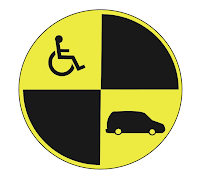What is the scope of WC19 and what does it require?
WC19 addresses a number of wheelchair design and performance issues related to protection of forward-facing occupants in frontal crashes. Most importantly, it requires that wheelchairs provide four easily accessible securement or attachment points for anchoring the wheelchair in place, facing forward in the vehicle using a WC18-compliant four-point, strap-type tiedown system. It further requires that an appropriately-sized crash dummy (i.e., anthropomorphic test device or ATD) sit in the wheelchair and that it be dynamically crash tested in a 30-mph frontal impact sled test.
However, the standard also addresses several other wheelchair design and performance issues, including requirements that:
- there should be an option of using a wheelchair-anchored pelvic/lap restraint belt, and a WC19 wheelchair shall be crash tested with such a belt restraining the lower torso of the ATD,
- the wheelchair shall be tilt tested and rated for lateral stability, and rating of good, acceptable, or poor shall be disclosed in the wheelchair manufacturer’s presale literature and user instructions,
- the wheelchair structure shall allow clear paths between securement points and typical vehicle anchor points,
- the wheelchair shall be tested and receive a rating of at least ‘acceptable’ for the ease of applying a vehicle-anchored belt restraint on the occupant and the degree to which proper belt positioning is possible,
- the wheelchair and wheelchair-anchored belt restraints shall be labeled as complying with WC19 with the symbol below,

- wheelchair-anchored postural belts provided by the manufacturer shall be labeled as “not for use as an occupant restraint in a motor vehicle,” and
- the wheelchair manufacturer shall provide information and warnings on proper securement and restraint procedures in product literature.
